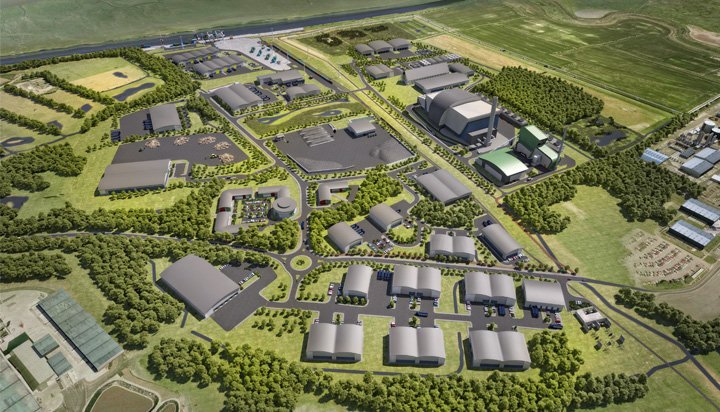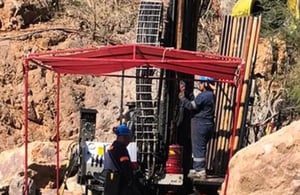Powerhouse Energy Group PLC (LON:PHE) Chief Executive Officer Keith Allaun caught up with DirectorsTalk for an exclusive interview to discuss their first international DMG distribution agreement with Tresoil and the supply potential to other countries.
Q1: If we could just start with the announcement on your first international distribution agreement for the DMG hydrogen from waste unit that’s going to be supplying hydrogen for bus projects in Bulgaria and Romania. Now, the agreement is with Tresoil, what can you tell me about them Keith?
A1: Well, Tresoil is a company that’s about 11 years old and has been working in the alternative energy space throughout the EU with a focus on Eastern Europe over the course of its existence.
We’ve been in contact with Tresoil on and off for nearly 5 years and identifying projects that made sense as we continued to mature the technology and redefine the technology. Once, we hit the go button, once we realised we had finally achieved the version of the technology that was replicable, commercialisable, extensible, modular, that met all of our criteria, we were ready to start developing relationships as we did with Waste2Tricity as a project development partner here in the UK.
With Tresoil, we looked at Tresoil as more of a project identification partner, particularly in the EU and particularly in the eastern EU and the reason we’re focussed on eastern Europe in the EU is because eastern Europe actually has some of the worse air pollution in the world, literally in the world. At one point, Sofia, Bulgaria was all but declared uninhabitable due to the quality of its air and the preponderance of that pollution is coming from particulate matter that is being spewed out by things like diesel buses.
So, the EU has a major push for the decarbonisation of public transportation and that basically means getting buses to be hydrogen- fuelled or battery-powered. The problem of course with battery powered is if your electricity is still being generated through brown coal, or coal, you’re just moving the CO2 and the particulate matter, and all of those things, from one place to another. Whereas with the hydrogen fuel cell bus, your emission is zero, you have a zero CO2 tailpipe emission and your emission is water vapour.
So, our focus is with our connection with the MOU we signed 6 weeks ago, and we’re moving towards contract with Wrightbus, the contract is with their lawyers now as we speak, to effectively jointly tender to provide turnkey solutions for cities to have both hydrogen production and hydrogen fuel cell bus fleets. The interesting thing is hydrogen fuel cell buses cost more than diesel buses, but the EU provides a €200,000 per bus rebate, making them effectively on-par with diesel buses and hydrogen fuel cell buses actually get better mileage per gallon equivalent of hydrogen than they do in diesel. Again, there’s zero CO2 footprint so it eliminates the particulates issue and it eliminates the greenhouse gas issue and that has a dramatic effect on the health of the region and the viability of the region and its ability to expand economically.
So, we’re really excited about the opportunities that we’re pursuing in eastern Europe, there are half dozen cities beyond Bucharest and Sofia that we’re pursuing for large bus tender procurement plans. They’re looking at initially 30 buses with the anticipation that over the next few years they’re going to be replacing up to 1,500 buses per city so that’s a pretty significant thing. If you look at the fact that TFL, Transport for London, recently acquired 23 hydrogen fuel cells buses, you understand that the fuel cell is actually becoming the mechanism of choice.
Not to go off on this but I was chatting to somebody from Scottish Power the other day who happened to be talking about the grid, the electric grid here in the UK, and its inability to keep up the hoped increase in use of battery-powered electric vehicles. The average person – they don’t have the ability to charge their vehicle at home, you can’t use a standard outlet to charge your electric vehicle at home – you need special equipment installed and you need to ensure that you have adequate power density through your lines to be able to provide charging for electric vehicles.
So, if you do 1 vehicle per 8 houses, you can potentially get away with it, if you do 2 electric vehicles per 8 houses, the infrastructure isn’t there yet. It’s going to start having an effect on the grid, it’ll have an effect on the local grid, they’re quite concerned that they’re looking at a 20 plus year project to bring the grid up to par in terms of its ability to provide charging fully for electric vehicles.
Our approach is to put the electricity on the bus, being made on the bus, being made on the car with a mobile fuel cell – Toyota has made the commitment to have 44,000 fuel cell vehicles on the road in Japan within the next 4 years, 44,000. The Metropolitan Police of London have made a commitment to acquire 550 new fuel cell vehicles for their police force in London over the next 2 years.
So, this is a trend that is growing, and this is something that is really quite significant and if one looks at what the barriers to entry have been historically for hydrogen fuel cells, it’s really been the advancement of the fuel cell technology which has finally come to the place where these mobile fuel cells are truly providing significant energy and power and – the cost of hydrogen.
Hydrogen is still an expensive fuel, and a very expensive replacement fuel, unless you use a technology like ours, the Powerhouse DMG, Distributed Modular Gasification technology, which allows us to produce and sell hydrogen at a cost that is on par with diesel and petrol and that completely changes the market dynamics. So, instead of having to pay price premium for an ecologically and energetically more efficient product, you no longer have to pay that premium because we can produce it at a cost that is accessible to the market.
We’re just getting started with the EU, the opportunities that the EU represents, they’ve truly made a significant monetary commitment of hundreds of millions of euros for public transportation infrastructure decarbonisation over there. They’ve got the political will to do it and the people who are farthest behind in the curve are the people in eastern Europe and as well as Poland and Hungary, there a number of opportunities we are pursuing aggressively, we’re in the final round of several large-sized grant applications. So, with those grants comes substantive money for feasibility studies, for proof of concept demonstration facilities for full-scale demonstration facilities, literally with the EU paying up to 70% of the capital cost for the development of these DMG facilities and that’s completely non-dilutive money for our shareholders to acquire that.
Powerhouse has been a company that has never acquired a single dime of government money, our business model has never been built on needing CFD’s or any of these government schemes to provide subsidies. We’ve always felt that our job is to be on the stand on our own and our business model needed to reflect the fact that we can make it without government handouts. We have absolutely shown that and proved that and that’s the case here in the UK, however if we have the luxury of being afforded non-dilutive money that’s going to benefit our investors, we are absolutely going to take advantage of it. So, adding this new skill set, if you will, to the mix, this skill set of being able to adequately compete, successfully compete for EU money is a tremendous opportunity for us.
Q2: I guess that’s where Tresoil come in, what can you tell me about the agreement there?
A2: The Tresoil agreement – Tresoil has relationships at very high levels with government throughout eastern Europe and so there in each of these cities, in each of these regions, they’ve got very high-level relationships that allows us ‘access to the table’ to discuss tenders and then to compete on a level playing ground.
So, Tresoil is involved in the identification of these projects and we’re anticipating the way things will roll out is we will put together SPC’s/SPV’S, special purpose vehicles or special purpose companies, that PHE will own at least half of and that Tresoil will own a minority stake in. Each of us is responsible for identifying investors to come to the table to fund those SPV’s and so, depending on the level of funding that we bring to those SPV’S, will typically lead to our level of participation in the SPV or our level of ownership in the SPV.
Under all circumstances, PHE will always be receiving a licencing revenue from those SPV’s, a technology licencing revenue, and that’s anticipated to be 20% of the net profit of the SPV as a whole, off the top. The rest of the SPV will be shared amongst the owners of the SPV who are anticipated to be Powerhouse, Tresoil, Waste2Tricity and then third-party providers. We are also, as I mentioned, working very closely with Wrightbus, we anticipate that through that relationship, we’ll be seeing some participation of these SPV’s as well.
Q3: What is the potential for the supply of your units across other cities in these countries?
A3: This is one of the things that excites me most, I know that at this time of the morning, after a long week, I may not sound super excited but let me tell you. We’ve always envisioned that with this concept of distributed modular gasification, DMG was going to be rolled out and that it was like a set of Legos that we could click together and commission in 30 days and have up and running and generating pure hydrogen energy for our customers.
We truly anticipate that there are hundreds, if not thousands, of opportunities for the distribution of DMG across Europe and the UK alone. If we look at the studies that have come out recently, they’re anticipating something in the neighbourhood of 1,200 hydrogen refuelling stations in the UK by 2050 and they’re anticipating over 400 fuelling stations in Germany alone by 2025 – so that’s just the tip of the iceberg.
The fact is, when you look at a survey that KPMG engaged in just recently, over 1,000 automobile executives, these are guys whose job it is to make investment decisions for automobile companies, they did this survey and the automobile executives came to the conclusion that hydrogen fuel cell vehicles, by the year 2030, were going to represent fully 25% of the automotive market. It’s unknown what percentage of the overall transportation market, our belief is that industrial transportation and marine transportation is going to have an even more rapid uptake of hydrogen fuel cells – and that battery-powered vehicles, we’re going to be looking at 26%. If you look at the fastest-growing trend in the market of mobile technologies, you see that hydrogen fuel cells are expected to be the fastest-growing trend for the next 6 years.
So, being involved now, we’re legitimately at the bottom of the J-curve, I’ve been saying this for months and it’s finally come out with validation from other third-party sources; McKinsey, KPMG, The Hydrogen Council, a variety of third-party sources who are indicating that hydrogen is truly the fuel of the future. The thing is, hydrogen is the material that actually fuels the sun and we’re able to extract that hydrogen from end-of-life materials, from waste plastics, from end-of-life tyres, and literally squeeze every drop of hydrogen energy out of those materials and provide a clean, green, economically efficient solution to our transportation needs immediately – and start having a significant impact on the influence of CO2 and particulates, those kinds of greenhouse gasses that are affecting our climate so dramatically.
Q4: Just talking about significant impact, your latest asset, an appointment for a Commercial Operations Manager, Bruce Nicholson, what does Bruce bring to the table?
A4: Bruce brings a very big brain. We’re extremely pleased to be working with Bruce and have identified Bruce.
Bruce has spent the past 25 years in the energy sector, both in alternative energy and in oil and gas, and he recognises that the future is represented by legitimate alternatives, his engagement with us and the future of hydrogen is something that truly excites him. Given his history of delivering multi-million pound and multi-billion-pound projects, both from a project management standpoint, from a business development standpoint, from a financial overview perspective, really provides us with the lynchpin, if you will, of our executive management team.
We’ve got a tremendous Chief Financial Officer in Chris Vanezis, we’ve got a tremendous Technical Director in Dave Ryan, we’ve now got Bruce on board engaged in commercial operations and I’m the CEO. When we added Dr Cameron Davies as Non-Executive Chairman last year, completely freed me up to begin to engage in the activities of building the company and building the infrastructure of this company and building external relationships for this company appropriately.
So, the four of us in this executive management team are able to, in a very ‘lean and mean’ way, get stuff done in a way that frankly the company has never seen. So, we’re just in tremendous strides, we’re moving forward aggressively with planning and permitting, we feel that should be done within the next couple of months, that we’re going to be able to start breaking ground – that we’re moving forward aggressively on the finalising of our commercial facility in the North West, the engineering finalisation.
We’re talking with significant engineering companies around the world who are interested in being part of our multi-hundred unit roll out. We’ve begun to structure this SPV mechanism which allows us to finance each of the facilities in a way that does not dilute our shareholders but brings the company superior value whilst minimising risk.
So, we really feel like we’re sitting in ‘the catbird seat’ and we are ‘one-of-one’ companies that are providing hydrogen from waste – we’re not a waste to energy company – we are a pure hydrogen energy company that happens to also generate electricity as part of the process. Our principal focus is on getting hydrogen into consumer use and industrial transport use and into marine use because, as was mentioned in a Shell report just 2 weeks ago, they don’t believe that there is any way for us to achieve our climate change imperatives, in the time necessary, unless we fully adopt hydrogen. So, they have made a significant commitment to hydrogen.







































